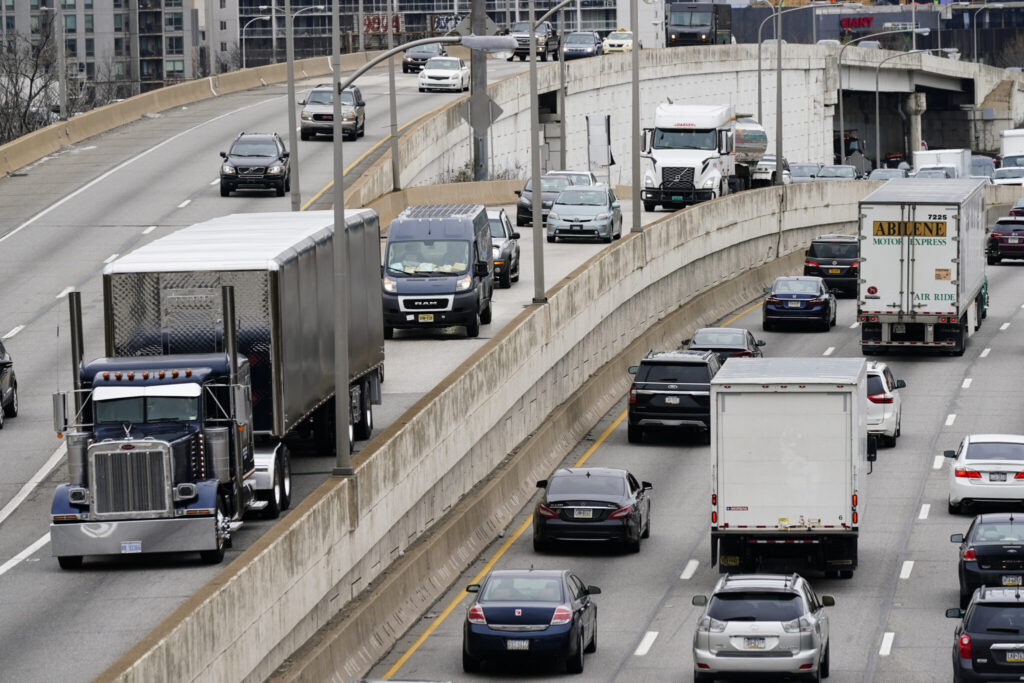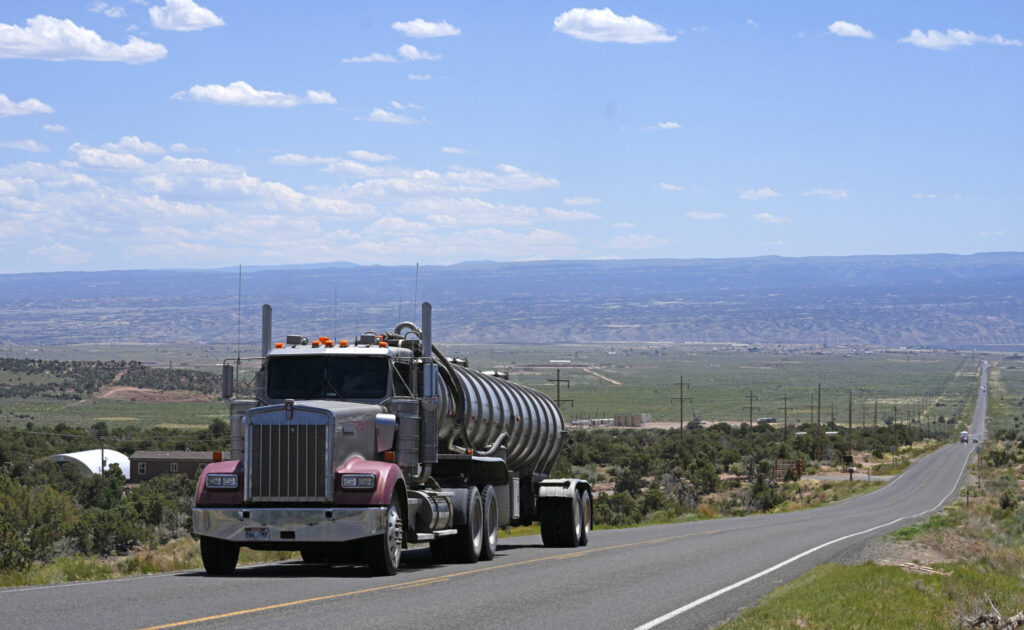The Environmental Protection Agency on Friday set strict emissions standards for heavy-duty trucks, buses and other large vehicles, an action that officials said will help clean up some of the nation’s largest sources of planet-warming greenhouse gases.
Quick Read
- EPA’s New Standards: The EPA has introduced stringent emissions standards for heavy-duty trucks and buses to reduce greenhouse gases and improve air quality.
- Impact: The regulations are projected to prevent up to 1 billion tons of greenhouse gas emissions and offer $13 billion in net benefits, including health improvements and reduced operational costs.
- Focus on Communities: The new standards are particularly beneficial for the 72 million Americans living near freight routes who are disproportionately affected by air pollution from heavy vehicles.
- EPA’s Vision: EPA Administrator Michael Regan emphasized the dual benefits of the standards: mitigating pollution and climate change effects while enhancing public health and economic efficiency.
- Complementary Regulations: These truck and bus standards follow the EPA’s recent passenger vehicle emissions standards, aligning with broader efforts to reduce transportation sector emissions.
- Industry Challenges: Despite the potential benefits, industry groups like the American Trucking Associations have expressed concerns over the feasibility of meeting these standards with current EV technology and infrastructure.
- Technology and Choices: The EPA asserts that the standards offer a range of compliance options, including hybrids and electric or hydrogen fuel cells, to accommodate different industry needs.
- Economic and Health Benefits: The regulations are expected to save operators $3.5 billion in costs from 2027 to 2032 and deliver immediate health benefits, particularly in heavily trafficked communities.
- Broader Environmental Goals: These standards are part of a comprehensive strategy to address transportation-related pollution and climate change, contributing to a healthier environment and society.
The Associated Press has the story:
EPA sets strict emissions standards for heavy-duty trucks and buses
Newslooks- WASHINGTON (AP) —
The Environmental Protection Agency on Friday set strict emissions standards for heavy-duty trucks, buses and other large vehicles, an action that officials said will help clean up some of the nation’s largest sources of planet-warming greenhouse gases.
The new rules, which take effect for model years 2027 through 2032, will avoid up to 1 billion tons of greenhouse gas emissions over the next three decades and provide $13 billion in net benefits in the form of fewer hospital visits, lost work days and deaths, the EPA said. The new standards will especially benefit an estimated 72 million people in the United States who live near freight routes used by trucks and other heavy vehicles and bear a disproportionate burden of dangerous air pollution, the agency said.

“Heavy-duty vehicles are essential for moving goods and services throughout our country, keeping our economy moving. They’re also significant contributors to pollution from the transportation sector — emissions that are fueling climate change and creating poor air quality in too many American communities,” EPA Administrator Michael Regan said.
“Reducing emissions from our heavy-duty vehicles means cleaner air and less pollution. It means safer and more vibrant communities. It means lower fuel and maintenance costs for truck owners and operators. And it means healthier Americans,” Regan said.
The new rules for heavy trucks and buses come a week after the EPA announced new automobile emissions standards for passenger vehicles. Those rules relax initial tailpipe limits proposed last year but get close to the same strict standards set out by the EPA for model year 2032.

The auto industry could meet the limits if 56% of new passenger vehicle sales are electric by 2032, along with at least 13% plug-in hybrids or other partially electric cars, the EPA said.
The rule for trucks is more complex, with a range of electric-vehicle or other non-traditional sales projected, depending on the type of vehicle and use, the agency said. For instance, 30% of “heavy-heavy-duty vocational” trucks would need to be zero-emission by 2032, the EPA said, while 40% of short-haul “day cabs” would need be zero emission vehicles.
The new rules for cars and trucks come as sales of EVs, which are needed to meet both standards, have begun to slow. The auto industry cited lower sales growth in objecting to the EPA’s preferred standards unveiled last April for passenger vehicles, a key part of President Joe Biden’s ambitious plan to cut planet-warming emissions.
“Our Clean Trucks plan works in tandem with President Biden’s unprecedented investments in America and delivers on this administration’s commitment to tackling climate change while advancing environmental justice,” Regan said.
The new rule will provide greater certainty for the industry, while supporting U.S. manufacturing jobs in advanced vehicle technologies, Regan said. Over the next decade, the standards “will set the U.S. heavy-duty sector on a trajectory for sustained growth,” he said.

Industry groups strongly disagreed. They lambasted the new standards as unreachable with current electric-vehicle technology and complained about a lack of EV charging stations and power grid capacity limits.
The American Trucking Associations and the Owner-Operator Independent Drivers Association, which represent large swaths of the industry, predicted supply chain failures and said that smaller independent firms would likely hang onto older diesel trucks that spew more pollution, running counter to the EPA’s goals.
The new limits lower zero-emission sales rates proposed for the 2027 through 2029 model years but require higher sales later, resulting in a practical mandate for electric and hydrogen-powered trucks, the trucking associations said in a statement. The EPA rule limits choices for trucks and buses to unproven technology, the group said.
“The post-2030 targets remain entirely unachievable,” said Chris Spear, the group’s CEO. “Any regulation that fails to account for the operational realities of trucking will set the industry and America’s supply chain up for failure.”
Todd Spencer, president of the independent drivers association, which represents small trucking companies, said the Democratic administration “seems dead-set on regulating every local mom-and-pop business out of existence with its flurry of unworkable environmental mandates.”
Regan said the EPA crafted the limits to give truck owners a choice of powertrains including advanced combustion vehicles, hybrids and electric and hydrogen fuel cells.
“There’s a list of options that truck drivers, owners and operators can choose from … while we (do) not sacrifice the very stringent environmental goals that we have set,” he told reporters Thursday.
The EPA calculated that new trucks would save operators a total of $3.5 billion in fuel and other costs from 2027 to 2032, paying for themselves in two to four years. The 2022 Inflation Reduction Act also provides tax credits that subsidize the purchase price of new electric vehicles, Regan said.
The new emissions limits will bring immediate health benefits, especially in communities burdened by heavy truck traffic, said Harold Wimmer, CEO of the American Lung Association.
“Transportation is the largest source of pollution driving climate change,” he said in a statement. “These strong standards that will help drive toward a zero-emission future for trucks, buses and other heavy-duty vehicles are a critical part of the solution.”






